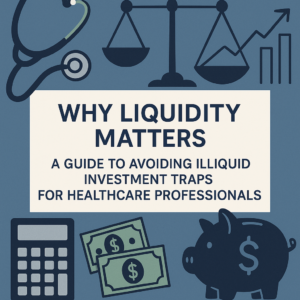Aggressive debt repayment focuses on paying off debt as quickly as possible through targeted strategies, prioritization, and disciplined financial habits. This comprehensive guide will introduce effective strategies to help you achieve aggressive debt repayment and regain control of your financial future.
Assessing Your Debt Situation
To create an effective debt repayment plan, you must first assess your current financial situation. This involves understanding the types of debts you have, their interest rates, and repayment terms. Here is how you can get started.
Types of Common Debts:
- Credit Card Debt: Credit card debt typically carries high-interest rates and can accumulate quickly if not managed.
- Student Loans: Many healthcare professionals have significant student loan debts from their education. These can be federal or private loans with varying interest rates and repayment options.
- HELOC (Home Equity Line of Credit): This type of debt is secured against your home and usually has adjustable interest rates after an intro period.
- Car Loans: Car loans are often lower interest but still need to be managed effectively.
- Personal Loans: These can be used for various purposes and usually have fixed interest rates.
Understanding Interest Rates and Repayment Terms:
- Interest Rates: Calculate the APR (Annual Percentage Rate) for each debt type you owe. Higher interest rates should generally be prioritized for repayment to save money in the long term.
- Minimum Payments: Identify the minimum payments required for each debt. Failure to meet these can result in late fees and damage your credit score.
- Term Lengths: Know the repayment terms for your loans, whether they are short-term or long-term. Understand the flexibility (or lack thereof) in altering these terms.
- Penalty Fees: Be aware of any penalty fees for late payments or early repayment.
Creating a Debt Repayment Plan
Once you have a clear picture of your debt situation, the next step is creating a structured repayment plan. Here’s a step-by-step guide:
Prioritize Your Debts:
- Highest Interest Rate First (Avalanche Method): Focus on paying off debts with the highest interest rates first while making minimum payments on others. This method minimizes the total interest paid over time.
- Smallest Balance First (Snowball Method): Focus on paying off debts with the smallest balance first. This method can provide quick wins and boost your motivation. For instance, paying off a $2,000 credit card balance before tackling a $25,000 student loan.
Calculate Available Resources:
- Monthly Budget: Create a detailed monthly budget to identify your income and expenditures. Determine how much extra money you can allocate toward debt repayment.
- Emergency Fund: Before allocating all extra funds to debt, ensure you have an emergency fund to cover unexpected expenses. This will prevent you from needing to accrue new debt in emergencies.
Allocate Extra Funds:
- Increase Income: Look for opportunities to generate additional income, such as taking on extra shifts, freelance opportunities, or part-time jobs during off-hours.
- Reduce Expenses: Identify areas where you can cut down on spending. This might include dining out less frequently, reducing subscription services, or getting a roommate to lower costs.
Automate Payments:
- Set up automatic payments through your bank to ensure you meet minimum payments and allocate extra funds to specific debts systematically.
Leveraging Tax Refunds and Reimbursements:
- Allocate any tax refunds or reimbursements you receive towards your debt repayment to make a significant dent without straining your regular budget.
Potential Pitfalls and How to Avoid Them
While aggressive debt repayment offers many benefits, there are potential pitfalls to be aware of. Here’s how to avoid common mistakes:
Ignoring Minimum Payments:
Ensure all minimum payments on debts are met to avoid late fees and damage to your credit score. Automate this process if needed.
Neglecting Emergency Fund:
Maintain an emergency fund to cover emergency expenses before channeling additional funds towards debt repayment. This prevents the need to incur new debt in emergencies.
High-Risk Behaviors:
Don’t borrow money or transfer balances without understanding the full costs and risks, such as transfer fees or higher interest rates after promotional periods.
Emotional and Physical Burnout:
Aggressive repayment can be stressful. Set realistic goals and timelines to maintain motivation. Take care of your mental health to avoid burnout. Practice stress management techniques such as mindfulness, exercise, or professional counseling if needed.
Aggressive debt repayment is a powerful strategy for young healthcare workers aiming to regain control of their finances and achieve financial freedom. By understanding your debt situation, creating a structured repayment plan, finding extra funds, and avoiding common pitfalls, you can make significant progress towards eliminating your debt.
Disclaimer: This blog post provides general information and is not intended as personalized financial advice. Each individual’s financial situation is unique, and strategies discussed may not be suitable for everyone. Readers should consult with a financial advisor to obtain advice tailored to their specific circumstances. The content is intended for informational purposes only and does not guarantee specific financial outcomes.






